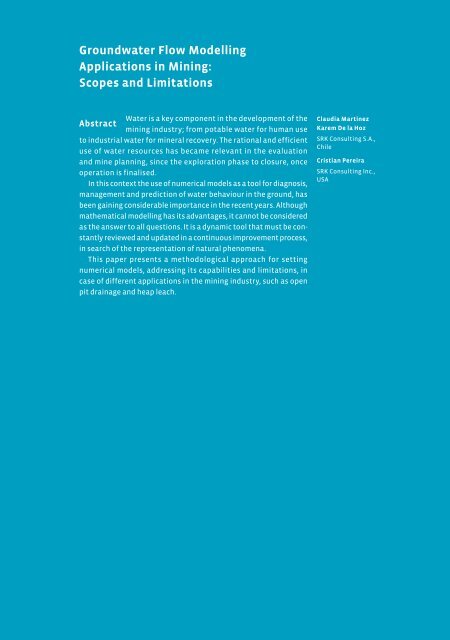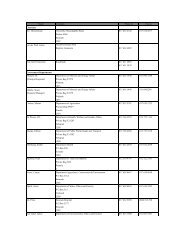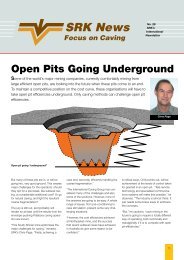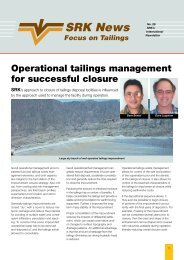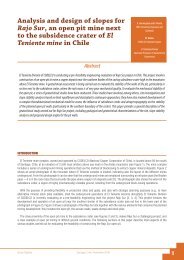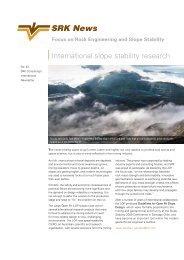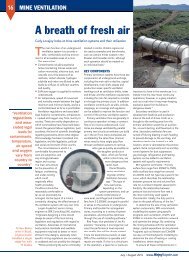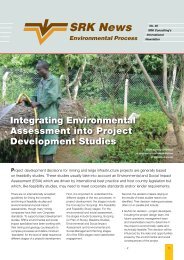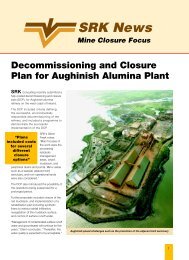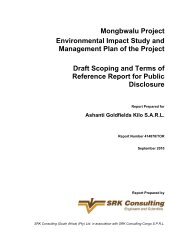Groundwater Flow Modelling Applications in Mining: Scopes and ...
Groundwater Flow Modelling Applications in Mining: Scopes and ...
Groundwater Flow Modelling Applications in Mining: Scopes and ...
Create successful ePaper yourself
Turn your PDF publications into a flip-book with our unique Google optimized e-Paper software.
<strong>Groundwater</strong> <strong>Flow</strong> <strong>Modell<strong>in</strong>g</strong><br />
<strong>Applications</strong> <strong>in</strong> M<strong>in</strong><strong>in</strong>g:<br />
<strong>Scopes</strong> <strong>and</strong> Limitations<br />
Water is a key component <strong>in</strong> the development of the<br />
Abstract<br />
m<strong>in</strong><strong>in</strong>g <strong>in</strong>dustry; from potable water for human use<br />
to <strong>in</strong>dustrial water for m<strong>in</strong>eral recovery. The rational <strong>and</strong> efficient<br />
use of water resources has became relevant <strong>in</strong> the evaluation<br />
<strong>and</strong> m<strong>in</strong>e plann<strong>in</strong>g, s<strong>in</strong>ce the exploration phase to closure, once<br />
operation is f<strong>in</strong>alised.<br />
In this context the use of numerical models as a tool for diagnosis,<br />
management <strong>and</strong> prediction of water behaviour <strong>in</strong> the ground, has<br />
been ga<strong>in</strong><strong>in</strong>g considerable importance <strong>in</strong> the recent years. Although<br />
mathematical modell<strong>in</strong>g has its advantages, it cannot be considered<br />
as the answer to all questions. It is a dynamic tool that must be constantly<br />
reviewed <strong>and</strong> updated <strong>in</strong> a cont<strong>in</strong>uous improvement process,<br />
<strong>in</strong> search of the representation of natural phenomena.<br />
This paper presents a methodological approach for sett<strong>in</strong>g<br />
numerical models, address<strong>in</strong>g its capabilities <strong>and</strong> limitations, <strong>in</strong><br />
case of different applications <strong>in</strong> the m<strong>in</strong><strong>in</strong>g <strong>in</strong>dustry, such as open<br />
pit dra<strong>in</strong>age <strong>and</strong> heap leach.<br />
Claudia Mart<strong>in</strong>ez<br />
Karem De la Hoz<br />
SRK Consult<strong>in</strong>g S.A.,<br />
Chile<br />
Cristian Pereira<br />
SRK Consult<strong>in</strong>g Inc.,<br />
USA
268<br />
CHAPTER 05<br />
INTRODUCTION<br />
Hydrogeological numerical models have become a frequently used tool for predictions<br />
related to water <strong>in</strong> m<strong>in</strong>e operations. <strong>Applications</strong> of hydrogeological<br />
numerical models <strong>in</strong>clude groundwater flow model for m<strong>in</strong>e dewater<strong>in</strong>g predictions,<br />
environmental vulnerability study of aquifer, surface water related to acid<br />
m<strong>in</strong>e dra<strong>in</strong>age <strong>and</strong> also a flow model focused on the heap leach dra<strong>in</strong>age.<br />
<strong>Groundwater</strong> flow to an underground m<strong>in</strong>e as to an open pit is generally threedimensional<br />
(3-d) <strong>and</strong> should be simulated by a three-dimensional numerical model.<br />
Therefore, a three-dimensional conceptual hydrogeological model needs to be built.<br />
On the other h<strong>and</strong>, heap leach irrigation process can be understood as a twodimensional<br />
(2-d) vertical flow <strong>and</strong> can be simulated by a simple two-dimensional<br />
numerical model. Also, the dra<strong>in</strong>age process of a heap leach pile <strong>in</strong>cludes the concept<br />
of unsaturated media. In this case a different set of parameters needs to be<br />
collected to simulate that process by a 2-d numerical model.<br />
This document shows a brief explanation of modell<strong>in</strong>g methodology, key parameters<br />
of different projects <strong>and</strong> two simple examples of application for open pit<br />
m<strong>in</strong>e <strong>and</strong> heap leach pile.<br />
GENERAL METHODOLOGY FOR MATHEMATICAL MODELLING<br />
What is a mathematical model? A classic <strong>and</strong> formal answer could be the follow<strong>in</strong>g:<br />
“a mathematical model is a representation of the essential aspects of an exist<strong>in</strong>g<br />
system (or a system to be constructed) which presents knowledge of that system<br />
<strong>in</strong> a usable form” [1]. For groundwater a numerical model represents the conceptual<br />
model of water flow. Numerical model is the second step of a series of activities.<br />
A simple methodology to build a mathematical model can be expla<strong>in</strong>ed <strong>in</strong> the<br />
follow<strong>in</strong>g stages (Figure 1):<br />
1. Def<strong>in</strong>ition of objective problem. What are the needs or requirements that should<br />
be addressed? What will be the pit <strong>in</strong>flow? Will the m<strong>in</strong>e dewater<strong>in</strong>g activities<br />
impact the surface water bodies? What is the rate at which a heap leach<br />
needs to be irrigated? If we manage to def<strong>in</strong>e clearly <strong>and</strong> <strong>in</strong> enclosed form our<br />
request, it is also possible to evaluate whether it is relevant or not to build a<br />
numerical model as a solution.<br />
2. Conceptual model. Conceptual model should be developed <strong>and</strong> matured before<br />
build<strong>in</strong>g the numerical model. It is essential to have field data characterisation<br />
to support our conceptual model <strong>and</strong> that allow as to calibrate the numerical<br />
model.<br />
3. Objectives of a numerical model. Specific goals of the numerical simulations<br />
should be def<strong>in</strong>ed along with the conceptual model. The scale of numerical<br />
mo del should be <strong>in</strong> accordance with the simulations objectives. A regional numerical<br />
model of a bas<strong>in</strong> with 500 km 2 for a pit dewater<strong>in</strong>g estimate cannot<br />
accord<strong>in</strong>gly reproduce the drawdown generated by pump<strong>in</strong>g 1 L/s <strong>in</strong> a large diameter<br />
well.<br />
4. Construction of a numerical model. A numerical code should be selected based<br />
on the previous stages to accurately reproduce the conceptual model <strong>and</strong> to<br />
achieve the proposed goals. At this po<strong>in</strong>t a second abstraction of the reality is<br />
done upon pass<strong>in</strong>g from conceptual model to the numerical model.<br />
5. Model calibration. Field data measurements should be reproduced by the mod-
<strong>Groundwater</strong> <strong>Flow</strong> <strong>Modell<strong>in</strong>g</strong> <strong>Applications</strong> <strong>in</strong> M<strong>in</strong><strong>in</strong>g: <strong>Scopes</strong> <strong>and</strong>...<br />
el with<strong>in</strong> a range of precision. Calibration should be <strong>in</strong> accordance with the<br />
scale of the numerical model <strong>and</strong> the expected solution. For example, to calibrate<br />
a water level with<strong>in</strong> a range of 1 cm is exaggerated if the objective is<br />
to verify drawdowns of more than 5 m <strong>in</strong> the water levels. Numerical model<br />
construction (geometry, boundary conditions, <strong>and</strong> hydraulics parameters) <strong>and</strong><br />
conceptual model need to be evaluated dur<strong>in</strong>g the calibration process to get a<br />
reasonable calibration.<br />
6. Model validation. Even if the model is calibrated, us<strong>in</strong>g field data, it should also<br />
be validated us<strong>in</strong>g the <strong>in</strong>dependent set of data, that differs from the one used<br />
<strong>in</strong> model build<strong>in</strong>g <strong>and</strong> calibrat<strong>in</strong>g.<br />
7. Model sensitivity. The sensitivity should be analysed <strong>in</strong> the range of confidence<br />
of the parameter measurements used to feed the model. In some cases, even a<br />
very small change <strong>in</strong> the value of these parameters will result <strong>in</strong> very different<br />
model responses (model robustness can be discussed here).<br />
8. Predictive simulation. Predictive simulation is the “last stage” of the modell<strong>in</strong>g<br />
process. This activity should be developed when it has got a reasonable calibration.<br />
The first predictive simulation is not necessarily the last stage of a modell<strong>in</strong>g<br />
project, s<strong>in</strong>ce the results of this simulation can be unreasonable <strong>and</strong> it<br />
would be necessary to check the previous stages (calibration, numerical model<br />
construction <strong>and</strong> even the conceptual model).<br />
Figure 1 <strong>Flow</strong> diagram of mathematical modell<strong>in</strong>g.<br />
Numerical modell<strong>in</strong>g should be understood as an iterative process <strong>in</strong> which the<br />
reasonableness of results <strong>in</strong> each step should be checked before proceed<strong>in</strong>g to the<br />
next step. If predictive simulation results are unreasonable, it is necessary to go<br />
back through calibrations to check assigned parameters <strong>and</strong> models extension, or<br />
even to change the conceptual model. This iterative process is necessary <strong>in</strong> order<br />
to keep predictions with<strong>in</strong> an acceptable range of error accord<strong>in</strong>g to the level of<br />
study, <strong>and</strong> not to receive disproportionate over- or underestimated values.<br />
On the other h<strong>and</strong>, time used on each stage of the modell<strong>in</strong>g process should<br />
be consistent with the stage requirements (Figure 2). Conceptual model, for example,<br />
can use between 30% <strong>and</strong> 40% of the efforts, <strong>and</strong> predictive simulation should<br />
use no more than 25% [2]. In general, objective def<strong>in</strong>itions <strong>and</strong> conceptual model<br />
should not take less than 25%, <strong>and</strong> the numerical model construction <strong>and</strong> calibration<br />
between 35% <strong>and</strong> 50%.<br />
WIM 2010 Santiago, Chile<br />
269
270<br />
CHAPTER 05<br />
LIMITATIONS<br />
Figure 2 Example of an acceptable time of work by modell<strong>in</strong>g activity.<br />
Even though the previously shown methodology is widely known to modellers,<br />
<strong>in</strong> most of the m<strong>in</strong><strong>in</strong>g projects data is limited. In general, the availability of data<br />
for build<strong>in</strong>g, calibrat<strong>in</strong>g <strong>and</strong> validat<strong>in</strong>g a model is reduced or nonexistent. This<br />
would represent the bigger <strong>and</strong> the most common limitation to the modell<strong>in</strong>g<br />
process <strong>and</strong> could lead to an idea of impossibility of build<strong>in</strong>g the model. However,<br />
<strong>in</strong> these cases a prelim<strong>in</strong>ary model could be a good tool for sett<strong>in</strong>g field<br />
work priorities <strong>in</strong> order to improve hydrogeological knowledge <strong>and</strong> to reduce the<br />
uncerta<strong>in</strong>ties of predictions.<br />
On the other h<strong>and</strong>, the model represents the hydrogeological media always as a<br />
porous media. In this sense fractured rock <strong>in</strong> m<strong>in</strong><strong>in</strong>g should be represented as porous<br />
media with average parameters.<br />
Geometry of different units <strong>in</strong> general has limited representation. To get a better<br />
representation a very ref<strong>in</strong>ed grid should be built <strong>and</strong> <strong>in</strong> that case files of model<br />
can become very heavy <strong>and</strong> take a long time to run. A regional model to analyse<br />
the effect of an open pit on groundwater levels often requires a lot more discretisation<br />
to analyse slope stability <strong>in</strong> the same pit.<br />
Work<strong>in</strong>g with the average parameters for hydrogeological units can make it difficult<br />
to get a good calibration <strong>and</strong> many modellers are tempted to make specific<br />
changes <strong>in</strong> few cells to obta<strong>in</strong> a better calibration. A good calibration should<br />
be obta<strong>in</strong>ed by us<strong>in</strong>g average parameters <strong>and</strong> gett<strong>in</strong>g a good representation of the<br />
different trends <strong>in</strong> water levels, drawdown, <strong>in</strong>flows <strong>and</strong> outflows, rather than by<br />
match<strong>in</strong>g levels <strong>in</strong> each well <strong>and</strong> mak<strong>in</strong>g specific changes.<br />
MINE DEWATERING MODELLING: KEY FACTS AND PARAMETERS<br />
M<strong>in</strong>e dewater<strong>in</strong>g requirements, active dewater<strong>in</strong>g options (if required), potential<br />
environmental impacts on groundwater levels <strong>and</strong> surface water bodies <strong>and</strong> postm<strong>in</strong><strong>in</strong>g<br />
conditions (pit lake formation or flood<strong>in</strong>g of the underground m<strong>in</strong>e) can<br />
be predicted <strong>and</strong> evaluated by us<strong>in</strong>g a 3-d numerical model. Numerical modell<strong>in</strong>g<br />
can also be used for sensitivity analysis <strong>and</strong> field work plann<strong>in</strong>g.<br />
A 3-d hydrogeological numerical model should be based on a 3-d hydrogeological<br />
conceptual model, which, <strong>in</strong> turn, should be based on a 3-d characterisation of<br />
groundwater data. Hydrogeological data necessary for a 3-d characterisation should<br />
primarily be collected <strong>in</strong> the area adjacent to the ore body <strong>and</strong> at a depth of at least 50<br />
m below the proposed ultimate bottom of the open pit or underground m<strong>in</strong>e [3]. This<br />
depth should be confirmed based on the particular hydrogeology of each project.
<strong>Groundwater</strong> <strong>Flow</strong> <strong>Modell<strong>in</strong>g</strong> <strong>Applications</strong> <strong>in</strong> M<strong>in</strong><strong>in</strong>g: <strong>Scopes</strong> <strong>and</strong>...<br />
Key parameters for a 3-d characterisation <strong>in</strong>clude: horizontal hydraulic conductivity<br />
values with<strong>in</strong> different hydrogeological units; vertical hydraulic conductivity<br />
(Kv) for specific units; water levels <strong>in</strong> plan-view <strong>and</strong> at different depths (to estimate<br />
lateral <strong>and</strong> vertical groundwater gradients); hydraulic connection between groundwater<br />
system <strong>and</strong> surface water bodies; <strong>and</strong> water chemistry with depth.<br />
M<strong>in</strong>e excavation can generate impact on the groundwater system up to 10 km<br />
from the ore body boundary or more, depend<strong>in</strong>g on the hydraulic parameters of the<br />
groundwater system. Then, a hydrogeological numerical model should have enough<br />
extension outside the ore body <strong>and</strong> below the bottom of the f<strong>in</strong>al m<strong>in</strong>e configuration<br />
(with an adequate vertical discretisation) to get a good estimate of the m<strong>in</strong>e <strong>in</strong>flow<br />
<strong>and</strong> impacts on both the groundwater levels <strong>and</strong> superficial water bodies.<br />
MODELLING OF UNSATURATED FLOW<br />
For unsaturated flow modell<strong>in</strong>g it is necessary to know the unsaturated hydraulic<br />
properties of the materials that are <strong>in</strong>volved <strong>in</strong> the model, such as Soil-Water Characteristic<br />
Curve (swcc) <strong>and</strong> the unsaturated hydraulic conductivity (Kr (ψΨ)).<br />
swcc can be estimated by laboratory test<strong>in</strong>g, by us<strong>in</strong>g data bases or by the gra<strong>in</strong><br />
size distribution curve of the material. There are various methods to adjust the<br />
swcc curve, among the most known are those developed by Brooks & Corey [4],<br />
Van Genuchten [5] <strong>and</strong> Fredlund et al. [6].<br />
Fredlund’s work st<strong>and</strong>s out among these authors. Fredlund [6] has developed a<br />
methodology to estimate the swcc based on the material gra<strong>in</strong> size distribution<br />
<strong>and</strong> a database of laboratory test<strong>in</strong>g for different types of soils.<br />
Unsaturated hydraulic conductivity can be estimated by several equations but<br />
the one developed by Van Genuchten [5] is the most widely used. This equation<br />
connects the negative or matricial pore pressure with the unsaturated permeability,<br />
based on the saturated hydraulic conductivity. The latter parameter should be<br />
estimated by permeability test<strong>in</strong>g (<strong>in</strong> situ or <strong>in</strong> laboratory). Moreover, s<strong>in</strong>ce soil<br />
permeability is a function of its density, it is necessary to know the density ranges<br />
that will be used <strong>in</strong> the model <strong>and</strong> carry out test<strong>in</strong>g on compacted samples <strong>in</strong> accordance<br />
with those density values.<br />
It is recommended to characterise the material as follows:<br />
• Estimate swcc (soil water characteristic curve).<br />
• Estimate specific gravity weight (Gs).<br />
• Estimate gra<strong>in</strong> size distribution <strong>and</strong> Atterberg limits.<br />
• Estimate <strong>in</strong> situ densities.<br />
• Estimate saturated hydraulic conductivity.<br />
• Estimate the unsaturated hydraulic conductivity curve.<br />
NUMERICAL MODELLING EXAMPLES<br />
Case 1: Open pit dra<strong>in</strong>age<br />
Passive <strong>in</strong>flow <strong>and</strong> drawdown extension for a pre-feasibility level study were estimated<br />
for a two pit excavation by a 3-d numerical model.<br />
Proposed pits will be excavated through 20 m to 25 m below the <strong>in</strong>itial water table,<br />
<strong>in</strong> a very low hydraulic conductivity sedimentary sequence with groundwater at<br />
very shallow location. Recharge <strong>in</strong> the area is reduced due to the high evaporation<br />
rate, then the water source for the pit <strong>in</strong>flow is ma<strong>in</strong>ly the groundwater storage.<br />
Excavation of pits was simulated as a one-time excavation at the first time step<br />
WIM 2010 Santiago, Chile<br />
271
272<br />
CHAPTER 05<br />
of the simulation. This condition will apply a very high stress on the system <strong>and</strong><br />
predict a large volume of water <strong>in</strong>flow to the pits at the beg<strong>in</strong>n<strong>in</strong>g of the simulation.<br />
However, <strong>in</strong>flow will be reduced <strong>and</strong> stabilised after a few days of runn<strong>in</strong>g<br />
time steps. As many models at scop<strong>in</strong>g <strong>and</strong> pre-feasibility levels, this exercise has<br />
very limited field data <strong>and</strong> is focused on obta<strong>in</strong><strong>in</strong>g an <strong>in</strong>itial knowledge of the<br />
groundwater situation, the future pits <strong>and</strong> the possible <strong>in</strong>flow <strong>and</strong> drawdown us<strong>in</strong>g<br />
a 3-d numerical model <strong>in</strong>stead of an analytical solution. This is considered an<br />
acceptable approach for a pre-feasibility level estimation.<br />
Passive <strong>in</strong>flow to the pits was estimated to be about 5 m 3 /hrs (Figure 3). A very<br />
high <strong>in</strong>flow rate (more than 100,000 m 3 /hrs) predicted at the beg<strong>in</strong>n<strong>in</strong>g of pit excavation<br />
is the result of the one-time excavation of the pit simulated at the first<br />
time step of the model. It is expected that <strong>in</strong> future stages of the study the gradual<br />
excavation of the pit will reduce this high <strong>in</strong>flow, which should be divided between<br />
different steps of the pit excavation. Results of this k<strong>in</strong>d of simulation allow<br />
hav<strong>in</strong>g a first estimation of pump<strong>in</strong>g requirements for m<strong>in</strong>e dewater<strong>in</strong>g.<br />
Case 2: Heap leach<br />
Figure 3 Predicted <strong>in</strong>flow to the pits.<br />
Behaviour of a heap leach under irrigation (both on top <strong>and</strong> on slopes) was evaluated<br />
to maximise the copper recovery.<br />
Historical data was studied to def<strong>in</strong>e the material variability. Samples were taken<br />
from both leached <strong>and</strong> pre-leach<strong>in</strong>g materials to characterise by hydraulic<br />
test<strong>in</strong>g <strong>and</strong> estimate their swcc by their gra<strong>in</strong> size distribution curve [6].<br />
Saturation distribution with<strong>in</strong> the pile on irrigation regime was estimated by a<br />
feflow 2-d vertical transient numerical model [7]. This model allowed identify<strong>in</strong>g<br />
the slope irrigation effect on the behaviour of water flow through the heap leach<br />
toe. The latter allowed an adequate estimate of the Security Factor to the slope slides.<br />
This type of modell<strong>in</strong>g allows to make a sensitivity analysis of the results us<strong>in</strong>g<br />
different materials <strong>and</strong> to evaluate which of those materials may generate a high<br />
phreatic level <strong>in</strong> the heap leach (Figure 4). High phreatic levels <strong>in</strong> the heap leach<br />
have a negative effect on the leach<strong>in</strong>g process. Particularly, <strong>in</strong> this case, the leach<strong>in</strong>g<br />
solution was observed leav<strong>in</strong>g the pile by above the dra<strong>in</strong>age system.<br />
The sensitivity analysis <strong>in</strong>volved reduc<strong>in</strong>g the Van Genuchten parameter “a”,<br />
allow<strong>in</strong>g the soil to reta<strong>in</strong> more humidity. Observations of the real pile show a<br />
slightly <strong>in</strong>creased phreatic level at the bottom of the pile compared to the phreatic<br />
level predicted by the model. This difference can be expla<strong>in</strong>ed by changes <strong>in</strong> the<br />
retention properties of the material after leached process has started.
<strong>Groundwater</strong> <strong>Flow</strong> <strong>Modell<strong>in</strong>g</strong> <strong>Applications</strong> <strong>in</strong> M<strong>in</strong><strong>in</strong>g: <strong>Scopes</strong> <strong>and</strong>...<br />
Calibration of this type of numerical models can be done aga<strong>in</strong>st flow measurements<br />
of the dra<strong>in</strong>age system, phreatic levels <strong>and</strong> moisture content measurements<br />
<strong>in</strong> the pile by piezometers <strong>and</strong> with depth (Div<strong>in</strong>er, gem2).<br />
The construction of the heap leach pad itself generates zones of heterogeneous<br />
materials <strong>and</strong> at this level of study it is not possible to analyse the <strong>in</strong>teraction between<br />
these zones along the pile.<br />
Figure 4 Heap leach model (a) variability of water level with<strong>in</strong> the pile <strong>and</strong> (b) slope stability analysis.<br />
CONCLUSION<br />
Numerical groundwater flow modell<strong>in</strong>g should be based on a conceptual model<br />
matured <strong>and</strong> validated by empirical data. In this sense, it is important to allocate<br />
at least 25% of the time to build the conceptual model <strong>and</strong> clearly def<strong>in</strong>e the objectives<br />
of this numerical model.<br />
Numerical modell<strong>in</strong>g should be understood as an iterative process <strong>in</strong> which the<br />
reasonableness of the results <strong>in</strong> each step should be checked before proceed<strong>in</strong>g to<br />
the next step. If predictive simulation results are unreasonable, it is necessary to<br />
go back through calibrations to check assigned parameters, extension of models or<br />
even change the conceptual model.<br />
Hydrogeological data necessary for a 3-d characterisation should primarily be collected<br />
<strong>in</strong> the area adjacent to the ore body <strong>and</strong> at a depth of at least 50 m below the<br />
proposed ultimate bottom of the open pit or underground m<strong>in</strong>e [3]. A hydrogeological<br />
numerical model should have enough extension outside the ore body <strong>and</strong> below<br />
the bottom of f<strong>in</strong>al m<strong>in</strong>e configuration <strong>in</strong> order to get a good estimate of the m<strong>in</strong>e<br />
<strong>in</strong>flow <strong>and</strong> impacts on the groundwater levels <strong>and</strong> superficial water bodies.<br />
Unsaturated flow theory is commonly used to estimate flow <strong>in</strong> heap leach,<br />
which allows determ<strong>in</strong><strong>in</strong>g different levels of saturation with<strong>in</strong> the pile. For this<br />
type of modell<strong>in</strong>g it is necessary to know the unsaturated hydraulic properties of<br />
materials (swcc, Kr, <strong>and</strong> saturated permeability). Results of this k<strong>in</strong>d of modell<strong>in</strong>g<br />
can expla<strong>in</strong> the behaviour of the heap leach <strong>and</strong> can also be compared to <strong>in</strong> situ<br />
measurements of water levels or moisture content.<br />
REFERENCES<br />
Eykhoff, P. (1974) System Identification, Parameter <strong>and</strong> State Estimation. Wiley & Sons. [1]<br />
Rykaart, M. (2008) Unsaturated Soil Mechanics <strong>and</strong> <strong>Flow</strong> Short Course. Santiago, Chile. [2]<br />
Ugorets, V. & Howell, R. (2008) 3-D Characterisation of <strong>Groundwater</strong> <strong>Flow</strong> <strong>in</strong> Hard-Rock<br />
Uranium Deposits – <strong>in</strong> publications of 2 nd International Symposium “Uranium: Resources<br />
<strong>and</strong> Production”, Moscow. [3]<br />
Brooks, R. H. & Corey. A. T. (1964) Hydraulic Properties of Porous Media. Hydrol. Pap. 3.<br />
Colorado State Univ., Fort Coll<strong>in</strong>s. [4]<br />
WIM 2010 Santiago, Chile<br />
273
274<br />
CHAPTER 05<br />
Van Genuchten, M. T. (1980) A Closed-form Equation for Predict<strong>in</strong>g the Hydraulic Conductivity<br />
of Unsaturated Soils. Soil Sci. Am. J. 44: 892-898. [5]<br />
Fredlund, D. G., X<strong>in</strong>g, A. & Huang, S. (1994) Predict<strong>in</strong>g the Permeability Function for Unsaturated<br />
Soil us<strong>in</strong>g the Soil-water Characteristic Curve. Canadian Geotechnical Journal,<br />
Vol. 31, No. 3, pp. 533-546. [6]<br />
wasy Institute for Water Resources Plann<strong>in</strong>g <strong>and</strong> Systems Research Ltd. (2006)<br />
feflow Software (version 5.2). [7]


